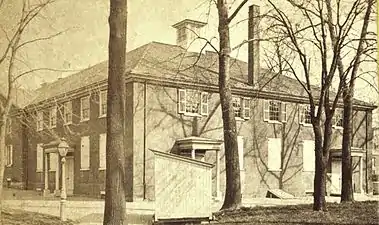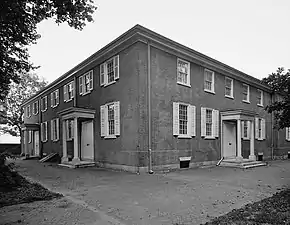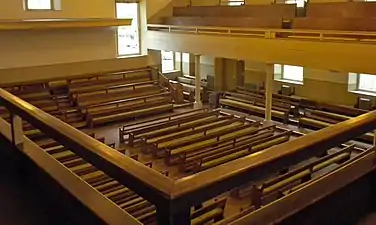Arch Street Meeting House | |
 Arch Street Friends Meeting House in 2013 | |
   | |
| Location | 320 Arch Street, Philadelphia, Pennsylvania |
|---|---|
| Coordinates | 39°57′7.2″N 75°8′50.17″W / 39.952000°N 75.1472694°W |
| Built | 1803–05, 1810–11 |
| Architect | Owen Biddle Jr. (central structure and east wing)[1] |
| NRHP reference No. | 71000716[2] |
| Significant dates | |
| Added to NRHP | May 27, 1971 |
| Designated NHL | June 23, 2011 |
| Designated PHMC | December 17, 1954[3] |
The Arch Street Meeting House, at 320 Arch Street at the corner of 4th Street in the Old City neighborhood of Philadelphia, Pennsylvania, is a Meeting House of the Religious Society of Friends (Quakers). Built to reflect Friends' testimonies of simplicity and equality, this building is little changed after more than two centuries of continuous use.
Pennsylvania founder and Quaker William Penn deeded land to the Society of Friends in 1701 to be used as a burial ground. The east wing and center of the meetinghouse was built between 1803 and 1805 according to a design by the Quaker master-builder Owen Biddle Jr. Biddle is best known as the author of a builder's handbook, The Young Carpenter's Assistant, published in 1805.[1] The building was enlarged in 1810–11, with the addition of the west wing.[1] Architects Walter Ferris Price and Morris & Erskine also contributed to the design and construction of the building. The firm Cope & Lippincott renovated the interior of the east wing and designed the two-story addition behind the center building in 1968–69.[4]
Today, the Meeting House continues to be a center for worship and the activities of the Monthly Meeting of Friends of Philadelphia[5] and Philadelphia Yearly Meeting.
Notable members of the Religious Society of Friends who worshiped at this meetinghouse include abolitionists and woman rights advocates, Sarah and Angelina Grimke.[6] Edward Hicks, the noted painter and cousin of Elias Hicks, also attended meeting here.[7]
The meetinghouse was listed on the National Register of Historic Places in 1971 and declared a National Historic Landmark in 2011.[8] The latter designation was as a consequence of the building being the only surviving documented work by Owen Biddle.[9]
Notable interments
The ground upon which the meetinghouse was built was the first burial ground for Quakers in Philadelphia.[10] Although the plot was officially given to the Society of Friends by William Penn in 1701, burials had been taking place here since as early as 1683. According to reports, Quakers were buried here alongside of “Indians, Blacks and strangers.”[11]
Notable interments include:
- Charles Brockden Brown (1771–1810), the first American novelist (Wieland)[7][12]
- Samuel Carpenter (1649–1714) and most of his family and his brother Abraham Carpenter (a non-member who married a Quaker) were buried in the Friends Burial Ground. Samuel was a Deputy Governor under William Penn and the "First Treasurer" of Pennsylvania.
- Lydia Darrah (1728–1789), Revolutionary War spy[13]
- John Eckley (1652–1690), First Purchaser, merchant and judge of the Provincial Court in Philadelphia.[14][15][16]
- James Logan (1674–1751), secretary to William Penn[7][12]
- Samuel Nicholas (1744–1790), founder and first commandant of the United States Marine Corps.[7] Each November 10, Marines mark his grave with a wreath at dawn.[17]
- Robert Waln (1765–1836), U.S. Congressman
- Dr. Thomas Wynne (1627–1691), personal physician of William Penn and one of the original settlers of Philadelphia in the Province of Pennsylvania. Born in Wales, he accompanied Penn on his original journey to America on the ship Welcome.
- Caspar Wistar (1761–1818), American physician, professor of anatomy and vice president of the American Philosophical Society. Wistar mentored Meriwether Lewis before Lewis joined William Clark on the expedition to cross the western part of the continent.[18]
Gallery
 John Lewis Krimmel, Sunday Morning (ca.1813)
John Lewis Krimmel, Sunday Morning (ca.1813) In the late 19th century
In the late 19th century The northwest corner (1974), photo by Jack E. Boucher
The northwest corner (1974), photo by Jack E. Boucher Interior (2010)
Interior (2010).jpg.webp) Historical marker
Historical marker
See also
References
Notes
- 1 2 3 Gallery, John Andrew, ed. (2004), Philadelphia Architecture: A Guide to the City (2nd ed.), Philadelphia: Foundation for Architecture, ISBN 0962290815, p.33
- ↑ "National Register Information System". National Register of Historic Places. National Park Service. January 23, 2007.
- ↑ "PHMC Historical Markers". Historical Marker Database. Pennsylvania Historical & Museum Commission. Archived from the original on December 7, 2013. Retrieved December 10, 2013.
- ↑ "Arch Street Meetinghouse - Related Architects, Engineers, and Others". Philadelphia Architects and Buildings. The Athenaeum of Philadelphia. Retrieved April 26, 2014.
- ↑ "Home". archstreetfriends.org.
- ↑ Gerda Lerner, The Grimke Sisters from South Carolina (Chapel Hill: University of North Carolina Press, 2004), 42.
- 1 2 3 4 "Arch Street Friends Meeting House". USHistory.org. Archived from the original on November 12, 2007.
- ↑ "AMERICA'S GREAT OUTDOORS: Secretary Salazar Designates 14 New National Historic Landmarks" (Press release). U.S. Department of the Interior. June 30, 2011.
- ↑ "NHL nomination for Arch Street Friends Meeting House" (PDF). National Park Service. Retrieved March 17, 2017.
- ↑ "Quaker Burial Grounds in Philadelphia 1683-present". Retrieved January 25, 2014.
- ↑ Watson, John (1830). Annals of Philadelphia. Philadelphia, E.L. Carey & A. Hart. pp. 449–450.
- 1 2 Philadelphia Graveyards and Cemeteries. Arcadia Publishing
- ↑ The WPA Guide to Pennsylvania
- ↑ Dunn, Richard; Dunn, Mary, eds. (1982). The Papers of William Penn (vol 2) (1st ed.). Philadelphia: University of Pennsylvania Press. p. 615. ISBN 0-8122-7852-6.
- ↑ Soderlund, Jean (1983). William Penn and the Founding of Pennsylvania (1st ed.). Philadelphia: University of Pennsylvania Press. p. 387. ISBN 0-8122-1131-6.
- ↑ "A Booke of records: of bierthes and burials in Philadelphia in the Province of Penezlvania in Amerrica". Philadelphia Congregations Early Records. Christ Church Preservation Trust. Retrieved February 2, 2022.
- ↑ Mucha, Peter (November 11, 2008). "Ceremony honors Marine Corps founder". The Philadelphia Inquirer.
- ↑ Wilson, Gaye. "The American Philosophical Society and Westward Expansion". Thomas Jefferson's Monticello. Retrieved April 7, 2014.
Further reading
- Barnes, Gregory. Philadelphia's Arch Street Meeting House: A Biography, Philadelphia, PA: QuakerPress, 2013.
- Bronner, Edwin B. "Quaker Landmarks in Early Philadelphia", Transactions of the American Philosophical Society, New Ser., Vol. 43, No. 1 (1953), pp. 210–216.
External links
- Official website

- Listing and photographs at the Historic American Buildings Survey
- Listing at Philadelphia Architects and Buildings
- Friends Arch Street Meeting House Burial Ground at Find A Grave
- Listing at visitphilly.com
- Listing in the Colored Conventions project

